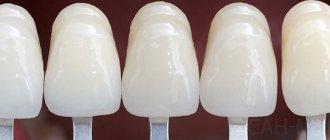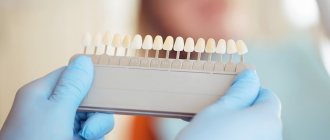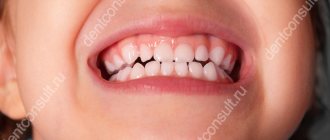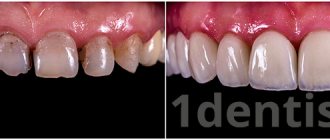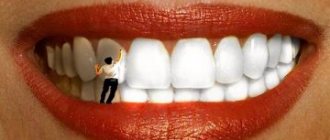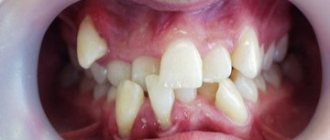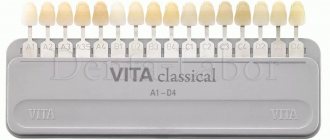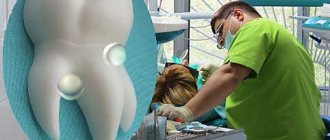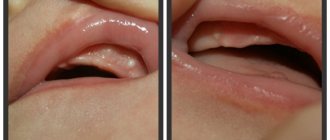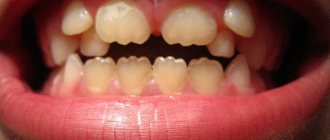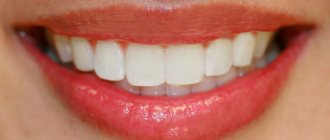A beautiful, attractive smile is very important for communication in the modern world. When meeting, it is customary to smile, at least out of politeness, and in moments of joy we involuntarily laugh with our mouths open.
Unfortunately, various pathologies can lead to a noticeable change in the color of one of the central teeth. This significantly reduces the aesthetic perception of the entire smile as a whole. Even one tooth of a different shade involuntarily attracts attention.
Tooth discoloration is a pathological change in color in the area of enamel, dentin, or both. There are two types – external and internal.
External discoloration
The reason is a pigmented plaque that forms on the roughness of the enamel, in microscopic cracks or anatomical cavities. Discoloration of teeth in this case is a consequence of consuming coloring products (tea, coffee, red wine, soda, etc.), smoking, and a reduced level of hygiene. Professional teeth cleaning at the dentist with mandatory enamel polishing, teaching the patient the rules of personal hygiene, and limiting the intake of coloring products will help get rid of it. In some cases, it is possible to use abrasive preparations.
What determines the shade of enamel
Its color is influenced by several factors:
- Dentin thickness. Dentin is the layer located between the pulp of a tooth and its enamel. Dentin itself has a yellowish tint.
- Transparency and thickness of enamel. The thinner and more transparent the enamel, the more noticeable the dentin shows through.
- The color of a person's skin and lips. The darker the skin, the lighter the teeth appear.
Some dentists say that the yellower the natural color of a person’s teeth, the less likely they are to experience caries. Since the yellowish natural tint indicates a thick layer of dentin, and, consequently, the strength of the tooth itself.
Internal discoloration of teeth
In this case, the color change occurs at a deeper level in the enamel or dentin of the tooth. Whitish erosive spots form on the teeth, which can turn yellow and black over time.
The cause of dental discoloration in this case is the penetration of certain substances into the body. In particular, the increased content of fluoride in drinking water (fluorosis) and the use of tetracycline antibiotics affect it. Violation of mineral and protein metabolism causes enamel hypoplasia - its absence or insufficient development. Age-related changes in the body also lead to thinning of the enamel and, in combination with external factors, yellowing and darkening can develop.
We list the local causes of discoloration:
- “dead tooth” or depulpation (nerve removal). Over time, the tooth becomes darker, grayer, yellower than vital,
- previous root canal treatment using the resorcinol-formalin method. Over time, the crown turns pinkish-brown,
- trauma during the growth of the dental system with the penetration of blood into the mineralization zone,
- Improperly performed orthodontic treatment can damage the ligamentous apparatus (periodontium) of the tooth, resulting in trophic disturbances and loss of vitality.
What is this condition
Discoloration is an abnormal change in the color of the enamel and/or dentin of teeth, that is, pigmentation caused by external or internal factors. If we break down the term into its components - “dis” and “color”, we get “change in coloring”. Normally, tooth enamel has a milky tint (due to the high calcium content). It is translucent and the thickness of the enamel layer is on average 1-1.5 mm. Under the enamel there is a thick layer of darker (yellowish) and opaque dentin - it is this that “sets the tone” for the tooth if the enamel is too thin.
Good to know! If teeth are naturally yellow, then it is difficult to talk about pathology. In this case, the shade is due to the thickness of the dentin - it gives yellowness. And bleaching won't help here. However, dentists note that such patients have stronger teeth and are less likely to be affected by caries - which is a definite advantage.
What is tooth discoloration
If the natural coloring of hard tissues changes, this will be visually noticeable. The crown can completely change shade or pigmentation appears in the form of stripes, spots (circles). As a rule, the closer to the gum level, the more pronounced the pathological tone is - dark, yellow, gray, brown, etc.
Treatment of dental discoloration
Aesthetic dentistry has various methods of treating discoloration:
intracanal bleaching – will help restore the light shade of a pulpless tooth,- in-office teeth whitening – brightens and evens out the color of enamel by several orders of magnitude,
- home teeth whitening with trays - can be done at home, but under medical supervision,
- installing veneers on teeth in the smile area will help eliminate discoloration due to internal causes of the body,
- installing a crown made of pressed ceramics completely imitates a living tooth in a row and will hide any defect.
Read more about tooth pigmentation
Discoloration (from the English word “discolor” - “change color”) of teeth is their persistent staining caused by various influences. According to statistics, today it is very common: it is diagnosed in more than 80% of patients in dental clinics. There are more men among them: they account for more than half of the cases, or rather 60%. Of course, it happens that yellow spots on teeth appear due to poor hygiene, which causes increased accumulation of plaque... But sometimes the yellow color of teeth is an anatomical feature of tooth enamel and dentin.
However, if they change color abruptly, then the reason may lie in the effects of sealers, medications or resocin-formalin. A stain on a tooth can also appear due to traumatic damage due to mechanical impact. As a rule, patients with discoloration that has arisen due to the influence of several factors resort to the services of a dentist. Experts have established a relationship between the color of enamel, its resistance, the correctness and regularity of oral hygiene measures.
How to treat discoloration at home
You can try to remove pigmented yellow and brown plaque with tooth powder or baking soda. The main thing here is not to overdo it and not damage the enamel layer. Highly abrasive pastes must be used very carefully - paste with charcoal can erase the enamel or leave scratches on it. It is recommended to use such toothpastes no more than 2-3 times a week.
There are ways to combat discoloration online using lemon juice and hydrogen peroxide. Most likely, such methods will not harm the teeth, but the effect will be insignificant.
More effective methods are based on a high concentration of hydrogen peroxide or urea. These are various sticks, strips, mouth guards with gel of dubious production from the mass market. These medications often cause tooth pain and sensitivity. These methods are not suitable for treating internal discolorations; you should visit a dental clinic and consult a dentist.
Methods for diagnosing pathology
To determine the type and degree of pigmentation of teeth, several studies are carried out - a visual examination, probing of a carious cavity or gum pocket, EDI (electroodontometry) to assess the viability of the dental “nerve”, X-ray or computed tomography, thermography to identify pathological processes in the periodontal tissues.
How is electroodontometry performed?
How does the procedure work?
Previously, eliminating cosmetic smile defects was possible only through the use of composite materials and the installation of crowns. Modern technologies make it possible to get rid of uneven staining of teeth without boron preparation; one of these technologies is microabrasion, or micro-abrasive treatment. The essence of the method is to grind off a microscopically thin layer of enamel, followed by polishing. Thus, this is not a therapeutic event, but a cosmetic one.
Due to the fact that the impact is only on the upper layers of enamel - the thickness of the removed layer is usually no more than 0.2 mm - this procedure does not lead to serious irreversible consequences. Microabrasive treatment minimally changes the contours of the enamel surface and is a more conservative method than tooth restoration with composite materials.
Microabrasive treatment does not require anesthesia, as it is painless. Before the procedure, the doctor decides on the need for professional hygiene. The dentist then determines the patient's natural enamel shade using the standard Vita scale and creates a treatment plan. The patient's eyes are protected with glasses.
Algorithm for the procedure:
- isolation of the working field using a rubber dam. Performed to protect the mucous membrane;
- applying an abrasive mixture to the surface of the tooth being treated and rubbing it in using slowly rotating attachments - cups. For microabrasion, the drug Opalustre is used, which contains microparticles of silicon carbide and 6.6% hydrochloric acid;
- rinsing off If the result is positive, move on to the next stage, if not, repeat the previous one;
- polishing the tooth surface with fine fluoride paste to achieve an optimal aesthetic result;
- registration of color changes.
As a rule, one visit to the clinic is enough to eliminate enamel discoloration. The best results are achieved by a combination of microabrasion and clinical bleaching.
What problems does dental restoration solve?
By contacting a specialist, you can eliminate the following shortcomings:
- remove microcracks and chips on tooth enamel;
- restore the lost crown part of the tooth or change its color;
- correct large gaps between teeth;
- change the abnormal shape of a tooth;
- remove spots (enamel hypoplasia, fluorosis);
- build up dental tissue if teeth are susceptible to wear.
Dental restoration is carried out in two ways: direct and indirect. The choice of method depends on the degree of damage.
The direct method allows layer-by-layer application of special composite materials onto the damaged tooth, which, after grinding and polishing, completely restore the tooth surface. The indirect method is classified as an orthopedic dentistry service and is carried out in several steps.
Teeth restoration is carried out using artificial crowns, veneers or special inlays.
Contraindications
The procedure is not recommended under certain conditions:
- tetracycline staining;
- moderate enamel underdevelopment;
- age-related staining;
- severely thinned enamel, cracks and erosive defects;
- wedge-shaped defects;
- exposed necks of teeth;
- severe form of fluorosis;
- pathologies of oral tissues;
- pulpless teeth.
Microabrasion is contraindicated for women during pregnancy and lactation. In addition, the procedure is not performed on baby teeth.
How to get rid of the problem
Here it is important to determine what type of pigmentation is present. Treatment of external and internal pigmentation is usually carried out using various methods. We invite you to consider them in more detail.
Professional oral hygiene
The easiest and fastest way to eliminate temporary or external enamel discoloration is professional oral hygiene. Using an ultrasonic scaler and Air-Flow air-abrasive cleaning, you can remove tartar and pigmented plaque. As a result, the teeth will become 1-2 shades lighter and return to their natural appearance.
The method is suitable if the pigmentation is superficial, i.e. the enamel layer did not have time to paint from the inside. Compared to regular teeth cleaning, professional hygiene has an advantage because... Only in a clinic can hard mineral deposits be removed from crowns.
Remineralization or remotherapy
Remineralization (by the way, it is better to do it after professional hygiene) can also make the enamel lighter by about 1-2 tones. Provided that before this she experienced a lack of minerals - calcium, phosphorus. The components of remineralizing compositions enhance the protective properties of enamel, making it stronger and a little lighter. The best option is deep fluoridation, because Only with this method do mineral substances penetrate deep into the enamel and remain in it for a long time. They do not settle on the surface and are quickly washed off when cleaning (as when using fluoride varnish).
Carrying out remineralization of teeth
Whitening in the clinic
Professional or in-office whitening[1] can lighten teeth by 8-15 shades. It is able to cope with fairly persistent external pigmentation, which is caused by the consumption of large amounts of coloring foods, drinks, and tobacco smoke. The method has contraindications - childhood, cracks in the enamel and its increased sensitivity. The most gentle technology is chemical Opalescence. The most effective are laser and ZOOM techniques.
Read more about laser teeth whitening – the pros and cons of this popular method of transforming your smile.
For internal whitening in dentistry, an intracanal or intracoronal method is used - this is how teeth that have once been treated for pulpitis and have become darkened are lightened. In place of the old fillings, a paste with sodium perborate is placed, and a temporary filling is placed. Within a few days, the paste lightens the darkened tissue, after which a new permanent filling can be placed.
Whitening at home
Home whitening, depending on the method, can make teeth 3-6 shades whiter. For whitening, hydrogen and urea peroxide are used - as in professional methods, however, for independent use, the concentration of active components is weaker. Home remedies with a potent effect are represented by gels (used in conjunction with mouth guards), strips, and special pencils. And also toothpastes with a high abrasiveness index - RDA more than 120 units. But before using them, you should definitely consult a dentist, undergo professional hygiene and remotherapy. Since any type of bleaching has contraindications. And the effect on teeth with a large amount of stone can be completely unexpected - the crown near the gums will remain dark, but near the cutting edge it will become very light.
Carrying out home whitening
Prosthetics with veneers, crowns
When none of the above methods are suitable for some reason (they have contraindications or they do not produce an effect), discoloration is eliminated using prosthetics. After all, the shade of the prosthesis, like the shape, can be chosen in absolutely any way. Thus, the front teeth are covered with aesthetic permanent ceramic overlays - veneers. Lateral or severely damaged anterior ones can be replaced with crowns, bridges made of zirconium dioxide, glass-ceramics, ceramics, metal-ceramics (preferably on the shoulder mass).
“Once upon a time, I was treated for pulpitis, so the “nerve” had to be removed. After 7 years, I noticed that the crown began to darken. It didn't look very good. The clinic advised me to put in one veneer to hide the darkening. First, however, the teeth were cleaned with special pastes to restore their color. And then the veneer was already done. It looks like home, I really like it now.”
Tatyana L., review from the dentistry.rf forum
Basic treatment methods
When the color of teeth changes to yellow or brown, the Atlantis Dental clinic in Moscow offers innovative treatment methods: remineralizing therapy, prosthetics, restoration with modern cements and composite materials. When changing the color of one tooth, internal bleaching is an effective technique. In this case, the canals are thoroughly cleaned and brightened with bleaching agents, after which a permanent filling is installed.
To restore the color of the enamel, medicinal applications with calcium and fluoride are prescribed, and electro- and phonophoresis are used. Aesthetic defects are corrected by lamination, direct veneering or restoration of surfaces with glass ionomer cement. In some cases, to eliminate discoloration, the affected teeth are covered with crowns.
Repairing a chip by installing a veneer
Among the advantages of this method, we note:
- The strength and aesthetics of ceramics helps to achieve a result that is completely similar to natural teeth.
- Veneers, especially those made of zirconium oxide, serve their owner for a long time - with proper care, up to 15 years.
- Veneers are not subject to discoloration from exposure to dyes and have a long service life.
- Dental plaque does not settle on ceramics, as a result of which stones do not form. Zirconium dioxide can withstand high temperatures and is characterized by high density and strength.
- Veneer materials do not shrink, so if installed correctly there will be no loss of fit.
Before installing veneers, the doctor warns the patient about the disadvantages of this method. Veneers are an expensive procedure that requires at least minimal grinding of the tooth and the work of a dental technician in the laboratory. Installation involves several visits to a specialist and fitting of the material. If even a minimal chip of the veneer occurs, a complete rework of the structure will be required.
Prevention and care recommendations
The health of teeth and their color closely correlates with the state of immunity, the presence or absence of chronic pathologies, and the level of hygiene. Caring for milk units in childhood is important. Prevention includes comprehensive measures:
- timely visits to the dentist (at least once every six months);
- detection and treatment of chronic diseases;
- drinking purified water;
- exclusion from the diet of drinks and foods with dyes;
- quitting smoking, as well as drinking coffee and strong tea.
Regular oral hygiene using medicated pastes, floss, threads, and rinses is important. Silicone trays and pastes with enzymes are also used to remove hard plaque and give yellow teeth a natural shade.
